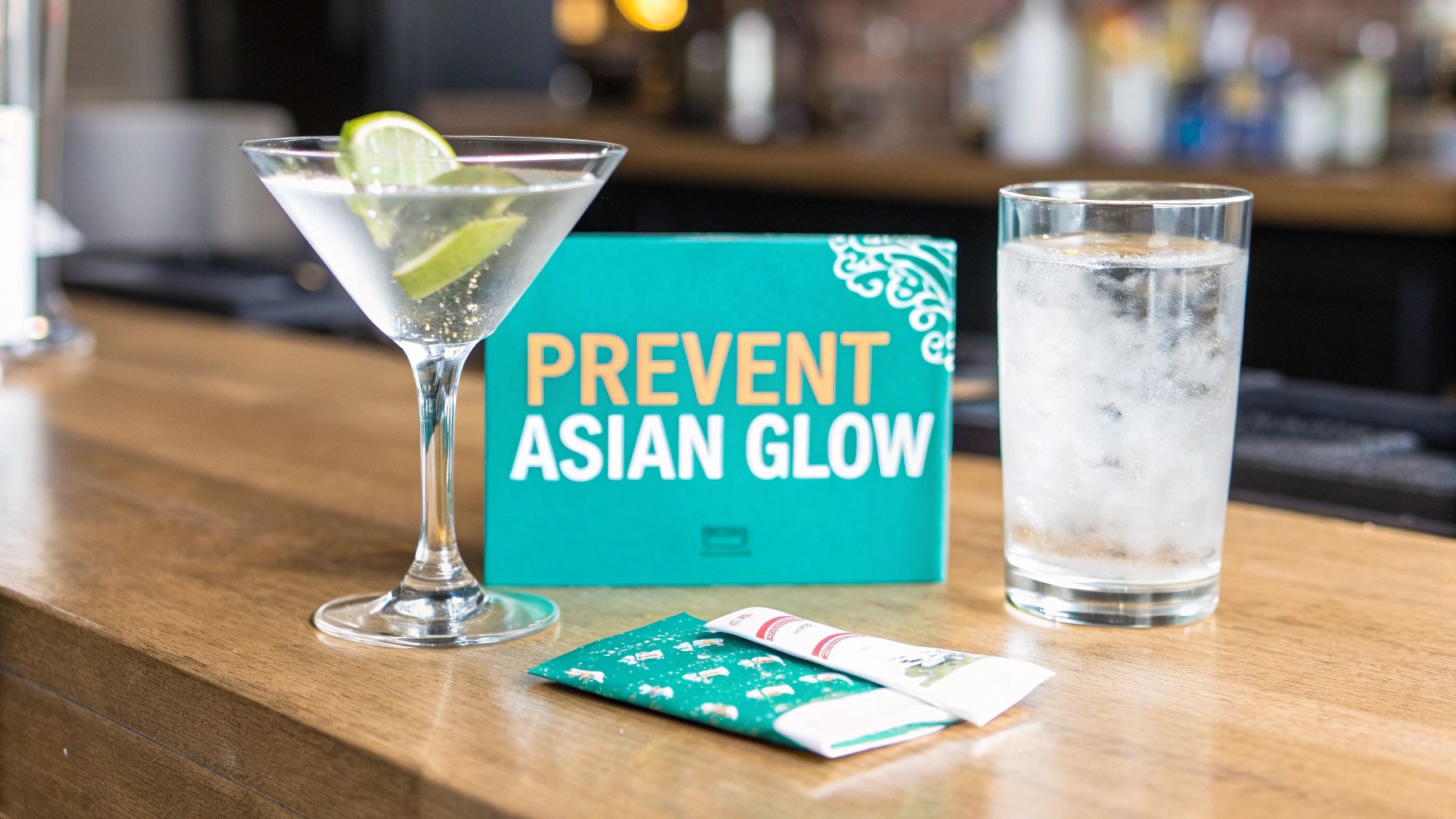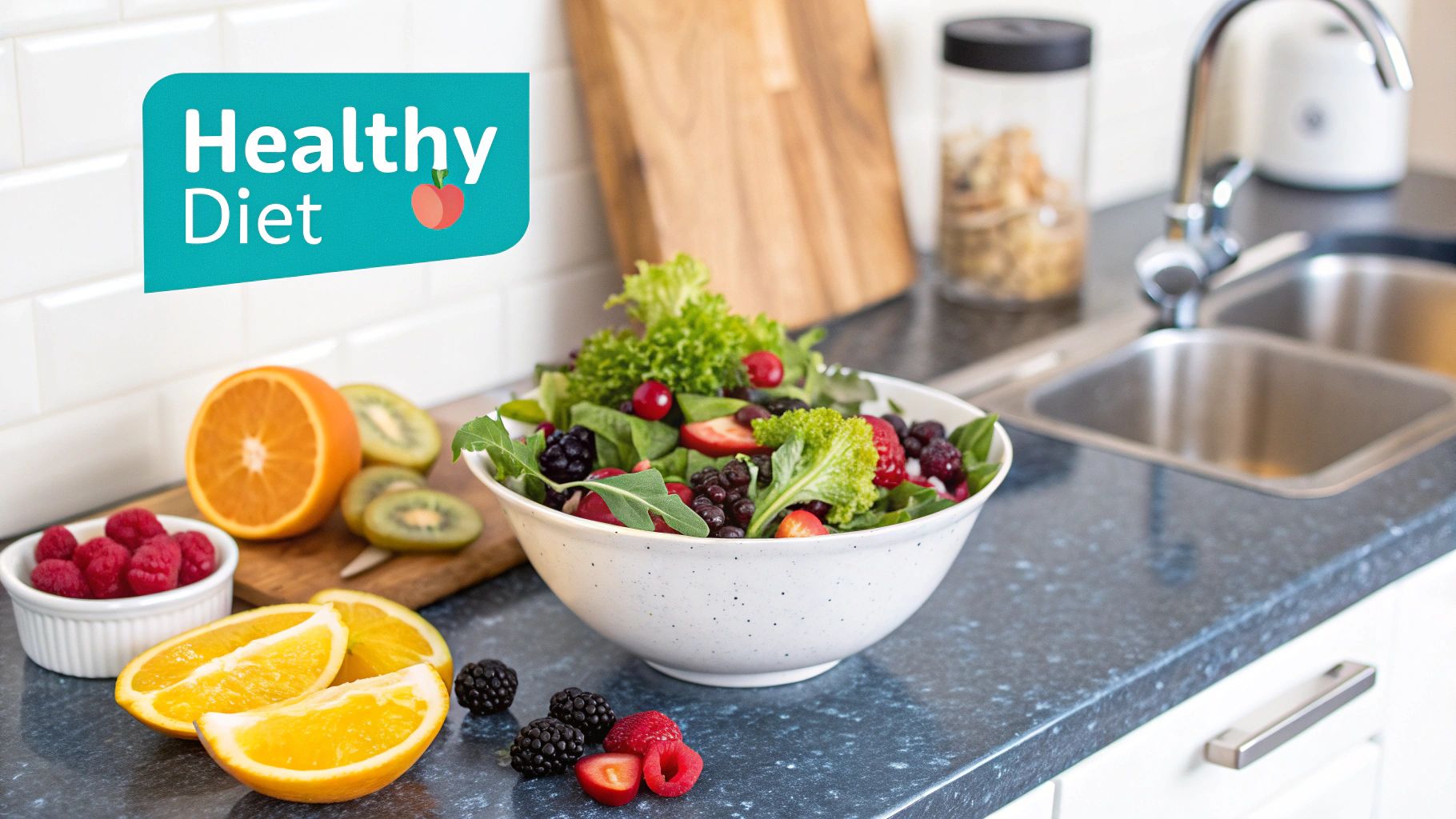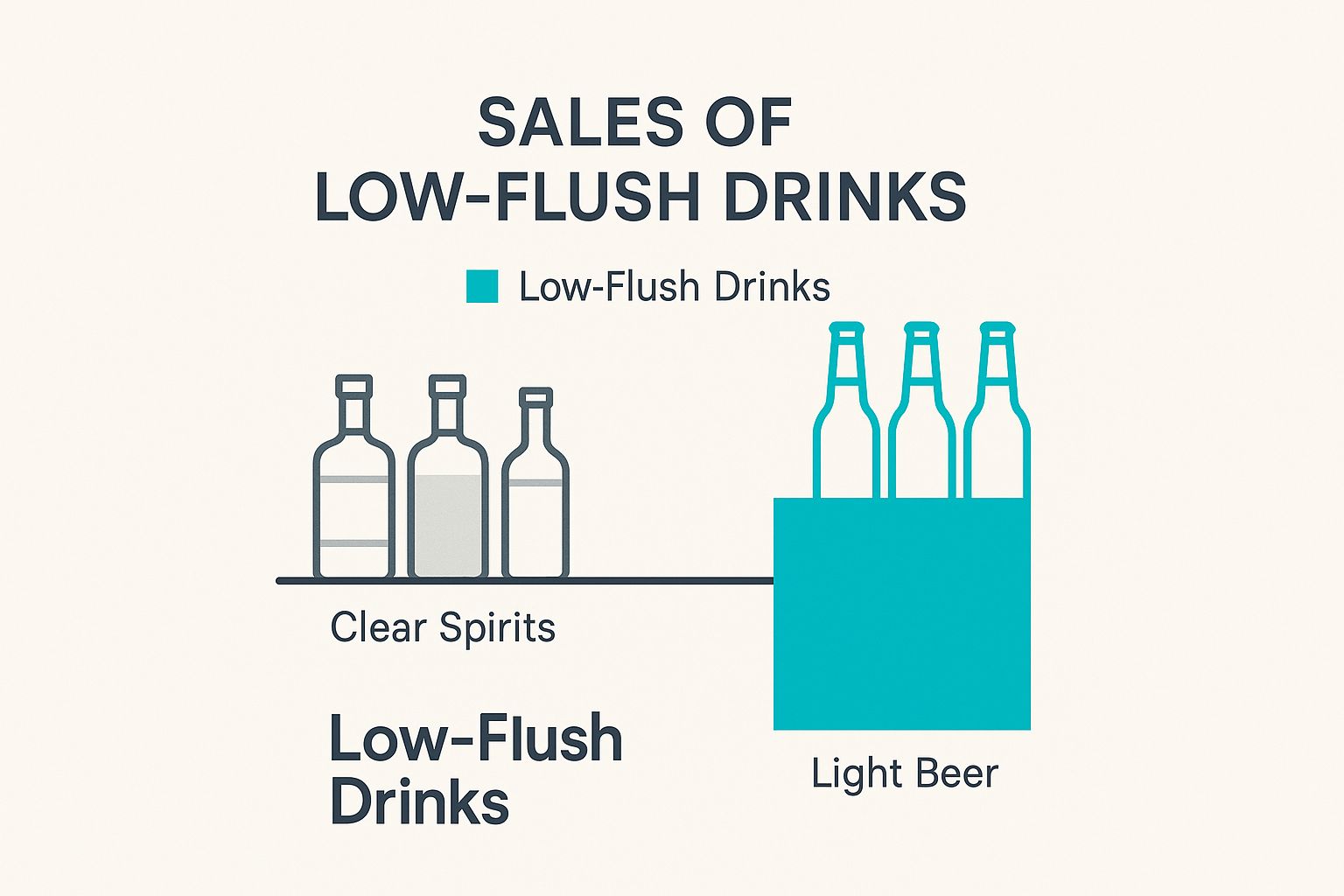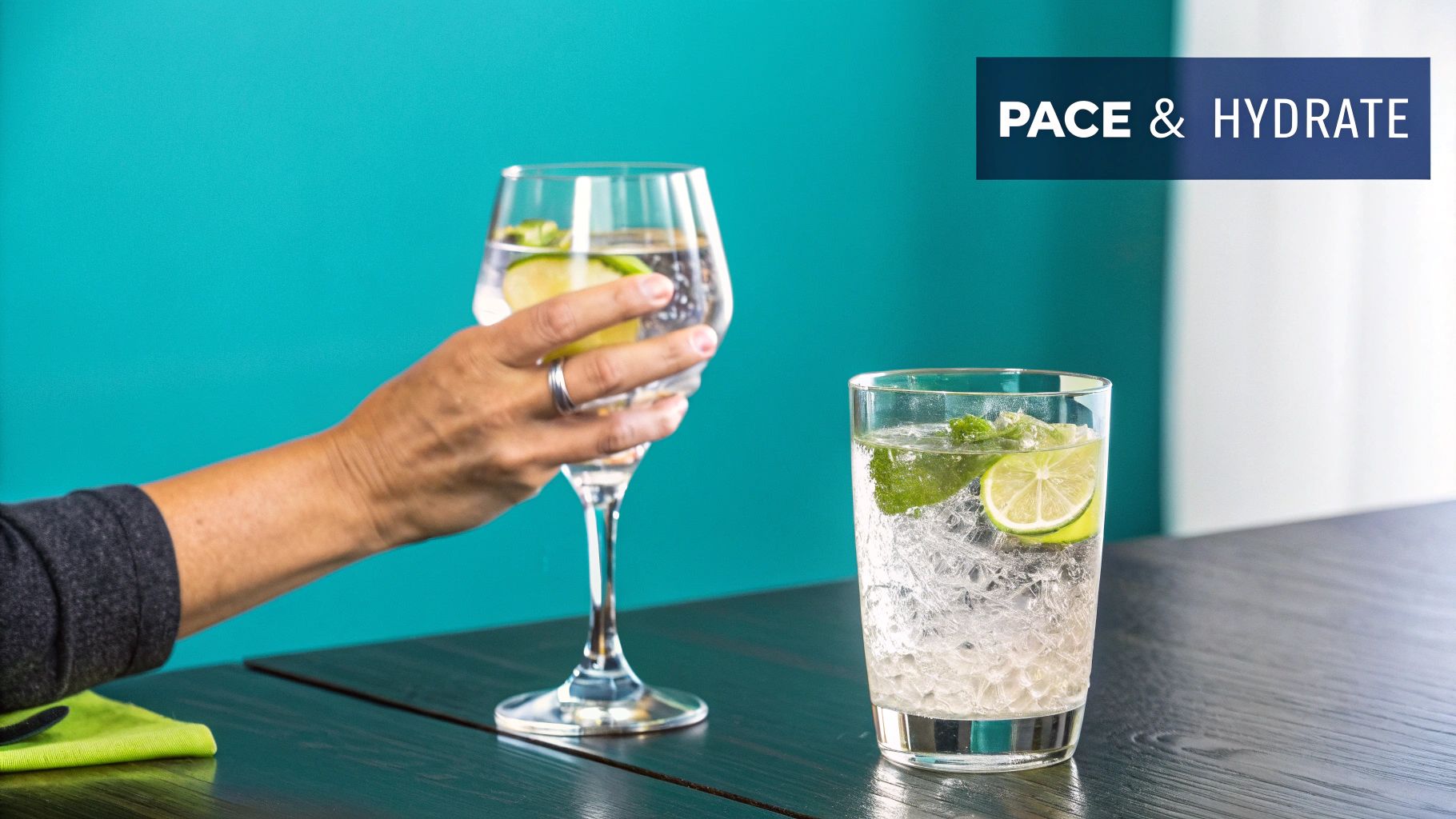

· By Annemarie
How to Prevent the Asian Glow: Tips & Solutions
If you've ever tried to enjoy a drink, only to be met with a beet-red face, a pounding heart, and a splitting headache after just a few sips, you know the “Asian glow” all too well.
Preventing it really comes down to one thing: helping your body process a nasty, toxic byproduct of alcohol called acetaldehyde. You can tackle this head-on with some smart preparation, better drinking habits, and the right supplements designed to give your natural metabolism a boost.
So, What Exactly Is the "Asian Glow"?
First things first, this reaction isn't an allergy, which is a common misconception. It's actually a genetic trait that messes with how your body metabolizes alcohol.
When you drink, your system breaks down the alcohol into that toxic compound, acetaldehyde. For most people, an enzyme called aldehyde dehydrogenase 2 (ALDH2) swoops in and quickly turns this toxin into a harmless substance. The whole process is so efficient they don't feel a thing.
But for some of us, there's a genetic hiccup in that process. You can get a more detailed look into this whole breakdown in our guide on how your body processes drinks.
The Genetic Hiccup
The real culprit behind the flush is a specific variation in the ALDH2 gene. It's pretty common, showing up in about 30-50% of people of East Asian descent, including those with Chinese, Japanese, and Korean heritage.
This gene variant means your ALDH2 enzyme is either way less active or completely inactive. Without that enzyme working at full speed, toxic acetaldehyde builds up in your bloodstream almost immediately, triggering all those uncomfortable symptoms.
Think of the flush as a warning signal from your body. It’s not just about looking red—it’s a clear sign that your system is overloaded with a toxin it can't handle. Understanding that is the first step to actually managing it.
What Acetaldehyde Buildup Feels Like
That buildup of acetaldehyde is what causes the whole collection of symptoms we call the alcohol flush reaction. A red face is just the most obvious part; what's happening internally can feel even worse. It helps to know the signs so you can recognize what your body is telling you.
Ever wonder if what you're feeling is actually the flush? Here’s a quick look at the common signs of acetaldehyde overload.
Signs of Acetaldehyde Buildup
| Symptom | What It Feels Like |
|---|---|
| Facial Flushing | A sudden wave of heat and redness spreading across your face, neck, and chest. |
| Rapid Heartbeat | That unnerving pounding or fluttering in your chest, also known as tachycardia. |
| Headache | A dull, throbbing pain that shows up way too quickly after you start drinking. |
| Nausea | A queasy, upset stomach, even if you’ve only had a tiny bit of alcohol. |
| Dizziness | Feeling lightheaded, unsteady, or like the room is spinning. |
Once you realize this is just a predictable biological reaction—not some kind of personal weakness—you can stop worrying and start looking for real solutions. All the strategies we’re about to cover are designed to support your body's metabolic pathways and keep that toxic buildup to a minimum.
The Hidden Health Risks of Ignoring the Flush

That tell-tale red glow creeping across your face is more than just an awkward party foul. Think of it as your body's own bright, flashing warning light. It's a signal that something is seriously wrong on a cellular level.
When your body can’t properly break down alcohol because of an ALDH2 deficiency, a toxic compound called acetaldehyde floods your system. This isn't just some harmless byproduct; acetaldehyde is a known carcinogen.
Repeatedly exposing your body to it is like revving an engine with no oil. Sooner or later, critical parts are going to break down. This internal damage isn't some far-off, hypothetical concern—it's a very real and documented risk.
From Redness to Real Risk
It’s so important to shift your mindset from just hiding the redness to actively protecting your long-term health. The science is pretty clear: consistent exposure to high levels of acetaldehyde can have some severe consequences.
Let's break down what's really happening under the surface:
- Increased Cancer Risk: This is the big one. Chronic acetaldehyde exposure is strongly linked to a much higher risk of certain cancers, especially esophageal cancer. The toxin literally damages the DNA in your cells, which can lead to malignant growths over time.
- Cardiovascular Strain: The same reaction causing your face to flush also puts a ton of strain on your heart and blood vessels. Research has connected ALDH2 deficiency with an increased risk for conditions like coronary artery disease.
- Liver Damage: Your liver does the heavy lifting when it comes to metabolizing alcohol. Forcing it to deal with a constant backlog of this toxin can lead to inflammation and long-term damage, hurting its ability to do its job.
The alcohol flush reaction isn't something to just "power through." It's a biological red flag. It means your body is being exposed to something it can't safely process, putting you at a significantly higher risk for serious health problems down the road.
The Surprising Link to Mental Health
The fallout from acetaldehyde isn't just physical; it can mess with your mental well-being, too. This is something researchers are paying more and more attention to as they uncover how this toxic buildup impacts brain chemistry.
Globally, an estimated 540 million people carry the ALDH2 deficiency, putting them in this high-risk group.
Take South Korea, where 36-45% of adults experience the alcohol flush reaction. A pretty startling study there found that flushers who drank even small amounts—less than one standard drink a day—were way more likely to develop depression compared to non-flushers. If you're interested, you can learn more about the research findings on mental health and alcohol flush from the full study.
This just goes to show that figuring out how to prevent the Asian glow isn't just about the physical side. It's also about protecting your mental and emotional health for the future.
Your Pre-Party Playbook to Minimize Flushing
How you prep in the hours leading up to that first drink can genuinely make or break your night. The goal here is to give your body a fighting chance to process alcohol without going into overdrive. Think of it like a pre-game ritual; a few smart moves beforehand can set you up for a much, much more comfortable experience.
Success starts with your last meal before heading out. And I mean it: do not drink on an empty stomach. A solid meal loaded with protein, healthy fats, and complex carbs is your best friend. These nutrients literally slow down how fast alcohol hits your bloodstream, giving your ALDH2 enzyme more time to do its job on that nasty acetaldehyde.
A perfect example would be something like grilled salmon with quinoa and avocado, or a hearty chicken and veggie stir-fry. This kind of meal provides a slow-release energy source, which helps prevent that sudden spike in blood alcohol that can overwhelm your system and trigger a major flush.
Fuel Your Body Strategically
Beyond just eating, proper hydration throughout the day is absolutely crucial. When you're dehydrated, the alcohol concentration in your blood skyrockets way faster. Make it a point to drink water consistently for a few hours before you even think about having a drink, not just chugging a glass right before you leave.
Another seriously effective strategy is bringing in some targeted supplements. This is where you can give your body a real edge.
Arming your system with specific nutrients designed to support alcohol metabolism isn't just wishful thinking—it's actively taking control. You're being proactive, not reactive.
The Power of Targeted Supplements
This brings us to one of the most effective tools in your playbook: supplements specifically formulated to help your body handle alcohol. Products like Upside Hangover Jelly are designed from the ground up to support your body through the metabolic stress of drinking.
The real power is in the ingredients. Let's break down two of the heavy hitters:
- Dihydromyricetin (DHM): This is a potent plant extract that has been studied for its ability to boost the enzymes that break down both alcohol and acetaldehyde. In simple terms, DHM helps your body clear this stuff out faster, cutting down on the toxic buildup that causes the flush.
- N-Acetyl Cysteine (NAC): NAC is a precursor to glutathione, which is basically your body's master antioxidant. Drinking depletes your glutathione levels, and NAC helps replenish them. This is huge for neutralizing the oxidative stress caused by acetaldehyde and protecting your cells.
Taking a supplement with these ingredients about 30-60 minutes before your first drink gives them time to get into your system and get to work. They essentially prep your liver and metabolic pathways for the job ahead. If you want to get into the nitty-gritty, you can check out our guide on the best supplements to take before drinking to really understand how they work.
When you combine a balanced meal, consistent hydration, and a high-quality supplement, you’re creating a powerful, three-pronged defense. This pre-party playbook won't change your genetics, but it gives your body the absolute best support to handle alcohol with minimal drama.
How to Drink Smarter Not Harder
Alright, you've prepped your body, and now the real test begins with that first sip. Managing your night out isn't about sheer willpower; it’s about having a smart, actionable game plan. The whole point is to keep your alcohol intake at a pace your body can actually handle, stopping that dreaded acetaldehyde overload before it even gets started.
A simple but incredibly effective move is the one-drink-per-hour rule. This isn't just about drinking less—it’s about timing. When you space out your drinks, you give your limited ALDH2 enzymes a fighting chance to process the alcohol and its toxic byproducts gradually. They won't get slammed with a massive, unmanageable spike.
To really make this work, alternate every single alcoholic drink with a full glass of water. Seriously. This isn't just for hydration, although that's a massive plus. It physically slows you down and dilutes the alcohol in your system, taking even more strain off your metabolism.
Choose Your Drinks Wisely
Not all drinks are created equal, especially when you’re trying to dodge the Asian glow. Some types of alcohol are packed with compounds that can make your reaction way worse, completely separate from the actual alcohol content. Becoming a savvy drinker is a huge part of learning how to prevent the Asian glow.
Two of the biggest culprits you need to watch out for are:
- Histamines: These are naturally occurring compounds, and they're especially high in fermented drinks like red wine and dark beers. Your body is already releasing histamines during the flush reaction, so adding more from your drink is like pouring gasoline on a fire. It just intensifies the redness and that stuffy-nose feeling.
- Congeners: These are chemical byproducts from the fermentation and aging process. You'll find them in high concentrations in dark liquors like whiskey, bourbon, and aged rum. They add flavor, sure, but they also place an extra burden on your liver, which is already working overtime.
This infographic breaks down some of the safer, low-flush options to consider.

When it comes down to it, clear spirits and light beers are generally your best bet because they're lower in these flush-triggering compounds.
Glow-Friendly Drink Choices
Navigating a drink menu can feel like a minefield when you're trying to avoid a flare-up. To make it easier, here's a quick cheat sheet comparing common drinks and their potential to trigger a flush reaction.
| Drink Type | Potential Flush Trigger Level | Why It Matters (Histamines, Congeners, etc.) |
|---|---|---|
| Red Wine | High | The absolute worst offender. Packed with histamines and tannins from grape skins, which are major triggers for redness and inflammation. |
| Dark Beer (Stouts, Porters) | High | High in histamines from the fermentation process. The complex ingredients can also add to the metabolic load. |
| Whiskey, Bourbon, Dark Rum | Medium to High | Loaded with congeners from the aging process in barrels. These add flavor but make your liver work much harder. |
| White Wine | Medium | Lower in histamines and tannins than red wine, but can still contain sulfites and other compounds that trigger a reaction in some people. |
| Light Beer (Lagers, Pilsners) | Low to Medium | Generally lower in both histamines and congeners than their darker counterparts, making them a relatively safer choice. |
| Clear Spirits (Vodka, Gin, Tequila) | Low | These are distilled, which removes most of the congeners. When mixed with simple, clean mixers (like soda water), they're often the safest bet. |
Choosing a vodka soda over a glass of Cabernet isn't just a random choice—it's a strategic move to keep those histamines and congeners out of your system.
Navigating Social Situations with Confidence
Knowing what to drink is one thing. Actually sticking to it in a social setting is a whole other challenge. The pressure to "keep up" is real, but your health is way more important than what anyone else thinks.
A great strategy is to always have a drink in your hand—but make half of them non-alcoholic. A sparkling water with a lime wedge looks identical to a vodka soda. It’s a simple trick that deflects questions and lets you control your pace without anyone noticing.
Your comfort and well-being are non-negotiable. Owning your choices with confidence is the most powerful tool you have. You're not "missing out"—you're actively choosing to have a better, healthier experience.
If someone does comment, a simple, confident reply like, "I'm just pacing myself to enjoy the night," is all you need to say. Remember, you’re the one in control. By drinking smarter, you’re making sure you can stay present and feel good, not just for the next hour, but for the whole evening and the morning after.
Building Long-Term Resilience to Alcohol Flush

Look, managing Asian glow is more than just popping a few supplements before a night out. While that definitely helps, the real game-changer is building a stronger, more resilient system over the long haul.
Think of it as setting a higher baseline for your health. When your body is already in good shape, it's just better equipped to handle the metabolic stress that comes from drinking alcohol.
A huge piece of this puzzle is your daily diet—not just what you eat an hour before happy hour. Focusing on foods packed with antioxidants is one of the smartest long-term plays you can make. The flush-causing culprit, acetaldehyde, floods your body with oxidative stress, and antioxidants are like your personal security team, neutralizing those damaging compounds.
Fortifying Your Body from the Inside Out
Making antioxidant-rich foods a regular part of your meals helps your body build and maintain a stronger defense system. You're basically keeping your cellular "ammo" stocked to fight off toxins.
Here are some of the best foods to work into your rotation:
- Berries and Dark Leafy Greens: Think blueberries, strawberries, spinach, and kale. They're loaded with vitamins that fight oxidative stress.
- Foods High in B Vitamins: Lentils, chickpeas, and salmon are great sources of B vitamins, which are critical for the enzymes that help metabolize alcohol.
- Liver-Supportive Foods: Cruciferous veggies like broccoli and Brussels sprouts have compounds that support your liver’s natural detox pathways.
Your daily choices really do create the foundation for how your body responds under pressure. A consistently healthy diet isn't going to change your genetics, but it gives your system the best possible tools to manage the effects of that ALDH2 deficiency.
This long-term mindset is becoming more common in how we approach Asian glow. Research is shifting towards a mix of education and proactive health habits. For instance, studies show that just being aware of the genetic risks linked to ALDH2 deficiency can encourage healthier drinking patterns.
The Role of Overall Wellness
Beyond what’s on your plate, your overall fitness level plays a pretty big part.
Regular exercise gets your circulation going and makes your metabolism more efficient, which means your body gets better at processing everything—and that includes alcohol. Staying active helps keep your liver and cardiovascular system healthy, both of which take a hit from acetaldehyde.
These long-term strategies all add up to a more robust system. They won't cure the genetic lottery you were dealt, but they can absolutely lessen how severe your reactions are over time. If you’re looking to give your system even more support, understanding how to increase alcohol tolerance safely through these kinds of holistic methods is key.
You're not just prepping for a night out—you're investing in your health for the long run.
Common Questions About the Asian Glow Answered
Even with a solid game plan, you probably still have some questions swirling around about the alcohol flush reaction. It’s a confusing topic, and let's be honest, there's a lot of mixed information out there.
We’ve rounded up the most common questions we hear to give you clear, straightforward answers. Think of this as your personal cheat sheet for handling the flush.
Can I Permanently Cure My Asian Glow?
The short answer? No. Since the alcohol flush reaction is a genetic trait tied to an ALDH2 enzyme deficiency, there’s no permanent cure right now. You can't just change your DNA.
But you can absolutely manage the symptoms.
It's helpful to think of it less like curing an illness and more like managing a food intolerance. All the strategies we've talked about—from pre-party prep to smarter drink choices—are designed to support the metabolic pathways your body already has. The goal isn't to get rid of the genetic trait, but to minimize that nasty buildup of toxic acetaldehyde so you can actually enjoy social drinking comfortably.
Are Antihistamines Like Pepcid a Safe Fix?
While some people reach for H2 blockers like Pepcid to dial down the redness, this is really not a great long-term solution. These meds only mask the most obvious symptom—the flush—by blocking the histamine response causing it.
Here's the problem: Using antihistamines gives you a false sense of security. Your red face might be gone, but the root issue—toxic acetaldehyde piling up in your system—is still happening behind the scenes. Masking this crucial warning sign can trick you into drinking more than your body can safely handle, which just increases your exposure to the very toxin you should be trying to avoid.
Can I Build a Tolerance to the Flush by Drinking More?
Nope, you can't build a tolerance to your own genetics. While you might get used to feeling crummy after a few drinks, trying to "power through" the reaction won't make your enzyme deficiency magically disappear.
In fact, consistently pushing through the flush is not just unhelpful, it's dangerous. You're forcing your body to swim in high levels of acetaldehyde for long periods. This is directly linked to the serious long-term health risks we covered earlier, like a higher risk for certain cancers. A much smarter—and safer—approach is to use strategies that work with your body, not against it.
Do Supplements Like Upside Hangover Jelly Actually Work?
Yes, a high-quality supplement designed specifically for alcohol metabolism can make a huge difference. Products like Upside Hangover Jelly aren't a magic wand, but they give your body the exact tools it needs to process alcohol more efficiently.
The real power is in their ingredients. Key players like Dihydromyricetin (DHM) and N-Acetyl Cysteine (NAC) have been studied for their ability to support the enzymes that break down acetaldehyde.
By giving your system this targeted boost, you can seriously reduce the flushing, headaches, and nausea. They don't change your genes, but they give your body the backup it needs to handle the challenge.
Share the Love!
Found this guide helpful? Spread the word and help someone else party smarter.
If you share this article, use a few of our favorite hashtags to join the conversation and connect with the Upside community. Let's put an end to the flush, together!
#upside #enjoyupside #upsidejelly #livemore #hangovercure #hangoverprevention #fighthangovers #preventhangovers #HangoverRelief #MorningAfter #PartySmarter #HydrationStation #WellnessVibes #RecoverFaster #NoMoreHangovers #HealthyParty #HangoverHacks #FeelGoodMorning #NightlifeEssentials #HangoverFree #SupplementGoals #PostPartyPrep #GoodVibesOnly #HealthAndParty #HangoverHelper #UpsideToPartying
